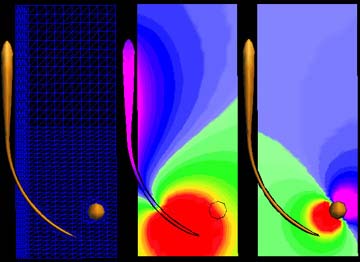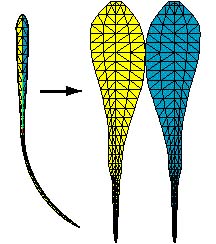Here is an image of a real fish (Apteronotus leptorhynchus) below two representations of a model used by the computer to represent the fish. We have developed a 3-dimensional electric field simulator using the boundary element method to study the sensory consequences of the fish's behaviors as it explores novel objects and interacts with the electric field of another nearby electric fish.

The left frame shows the 3-d fish body and object, as well as the points in the midplane at which the electric potential was simulated. The potential solution was linearly interpolated over the triangles shown in the blue mesh. The middle frame depicts the head-negative peak of the EOD, with the rainbow color scale ranging from purple (<= -10 mV) to red (>=10 mV), and the lightest blue at 0 mV. The rightmost frame shows the difference that the object makes: when we subtract the field simulated without the object from the field with the object present, the object's effect can clearly be seen as an induced dipole field. (The potential difference has been magnified by a factor of 100 to make it visible on this color scale.)
 We are now studying
the difference the object makes in the currents across the skin, where the
fish has its receptors. To see the entire electrosensory stimulus pattern,
the model fish can be "skinned" as shown in this schematic. The skin from
the left side (yellow) and the right side (cyan) of the 3d body is flattened,
and the simulation results can then be mapped to the corresponding points
on this flattened surface.
We are now studying
the difference the object makes in the currents across the skin, where the
fish has its receptors. To see the entire electrosensory stimulus pattern,
the model fish can be "skinned" as shown in this schematic. The skin from
the left side (yellow) and the right side (cyan) of the 3d body is flattened,
and the simulation results can then be mapped to the corresponding points
on this flattened surface.
Results of these simulations are in preparation for publication and will be posted here shortly.